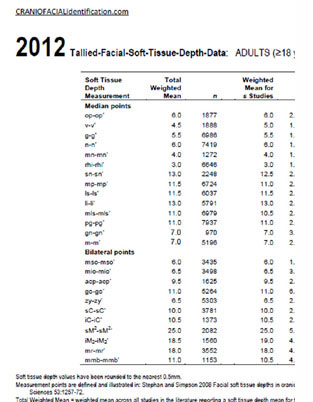
Data: C-Table & T-Table
C-Table - The Collaborative FSTT Data Repository
.jpg)
Volunteer your raw data
C-table contributor list
Terms of Use (please read prior to opening, using or downloading any of the C-Table, or related TDStats files)
Access the C-table:
v2018.0 cvs file
v2018.0 xls file
OVERVIEW: The C-table represents a centralised online repository of raw FSTT that is freely available in collaborative interests of contributors within the field. The C-Table is updated on a continuing basis as additional data are contributed. Currently, the respository holds data for >1,700 individuals, collected at up to 25 standardized craniofacial landmarks.
These data has been voluntarily contributed by principal investigators of prior studies that typically have been published, so that other investigators can use them in future work and validation testing. This is extremely valuable because it is uncommon for raw data to be published in modern studies making it impossible for single practitioners to make valid scientific comparisions or test new models in established samples. The C-table, therefore, plays a crucial role in: accelerating research which otherwise would not be possible; facilitating more comprehensive data analysis; cross-checking results; and maximizing data utility of original authors that takes substantial effort to originally derive.
Pracitioners typically contribute raw data to the C-table in the interests of scientific enquiry, and academic collegiality. Note here that raw data that have been published in the literature (typically small samples from historic papers) have automatically been added to the C-table. Investigators who have published but have not volunteered their own raw data to the C-table are strongly encouraged to do so BEFORE downloading and using the data freely provided by others. If you are going to use data first collected by your colleagues, please ensure you make your own FSTT available to them too.
The C-Table includes adult and subadult data reported by age, sex, ancestry, body height and body weight. Soft tissue depth measurement landmarks are restricted to the format of the T-Tables to provide standardization and consistancy between studies (only two additional landmarks to the present-day T-Table are included since these landmarks already carry borderline popularity in the FSTT domain: 'metopion' and 'supraglabella'. These landmarks may change as data submissions accumulate in the future. Data for left and right sides have been presented where possible for bilateral landmarks, however, the left side forms the default entry for any unspecified and/or averaged L/R values.
Contributing your raw data to the C-Table offers your previously published work the advantage of additional citations by other authors when they draw upon and use your data in future studies.
Please read the Terms of Use before opening or downloading the C-Table.
T-Tables - The Global Tallied FSTT Data
 Terms of Use (please read prior to opening or downloading any of the T-Tables)
Terms of Use (please read prior to opening or downloading any of the T-Tables)
The current T-Tables tally published FSTT data up to the end of 2023.
These very latest T-Table Data can be found in:
T.W.P.T. Hona, C.N. Stephan, Global facial soft tissue thicknesses for craniofacial identification (2023): a review of 140 years of data since Welcker’s first study, International Journal of Legal Medicine 138 (2024) 519-535. https://doi.org/10.1007/s00414-023-03087-x
Prior versions are available at the following links:
2018v - C.N. Stephan, 2018 Tallied facial soft tissue thicknesses: adult and sub-adult data, Forensic Science International 280 (2017) 113-123.
https://doi.org/10.1016/j.forsciint.2017.09.016
2014v - C.N. Stephan, The Application of the Central Limit Theorem and the Law of Large Numbers to Facial Soft Tissue Depths: T-Table Robustness and Trends since 2008, Journal of Forensic Sciences 59(2) (2014) 454-462. https://doi.org/10.1111/1556-4029.12328
2008v(adults) - C.N. Stephan, E.K. Simpson, Facial soft tissue depths in craniofacial identification (Part II): An analytical review of the published sub-adult data, Journal of Forensic Sciences 53(6) (2008) 1273-1279. https://doi.org/10.1111/j.1556-4029.2008.00853.x
2008v(subadults) - C.N. Stephan, E.K. Simpson, Facial soft tissue depths in craniofacial identification (Part I): An analytical review of the published adult data, Journal of Forensic Sciences 53(6) (2008) 1257-1272. https://doi.org/10.1111/j.1556-4029.2008.00852.x
OVERVIEW: The T-tables represent pooled FSTT from an extensive list of previously published studies.
The T-tables offer three sets of soft tissue depth data spread across various stages of the human life cycle: birth to 11 years, 12 to 17 years, and 18 years and beyond. In contrast to seperate studies that typically include fewer than 40 individuals, each of the T-tables report values for more than 3,000 individuals at the more commonly measured craniofacial landmarks.
The T-tables have been generated by collapsing prior data using weighted means and standard deviations within the above mentioned age ranges. This provides global datasets that are justified because current uncertainty levels for soft tissue depth measurement (and casework application of data) are large enough to overwhelm the small differences that result from variables such as age, sex, and ancestry/population affinity.
In contrast to any single soft tissue depth study, the T-tables holds three prime advantages: i) systematic and random biases specific to each investigation/measurement method are pitched against one another to triangulate upon population parameters; ii) the data are based on very large sample sizes; and iii) small differences, relative to measurement errors, are not used to tenuously sub-categorize the data.
Please read the Terms of Use before opening, using or downloading any of the T-Tables.